Change Detection Using Down-Looking Ground-Penetrating Radar
April, 2014
IDA document: D-5154
FFRDC: Systems and Analyses Center
Type: Documents
Division:
Authors:
IDA document: D-5154
FFRDC: Systems and Analyses Center
Type: Documents
Division:
Authors:
Authors
Elizabeth L. Ayers, Eric Bressler, Marie E. Fishel, Erik M. Rosen
See more authors

